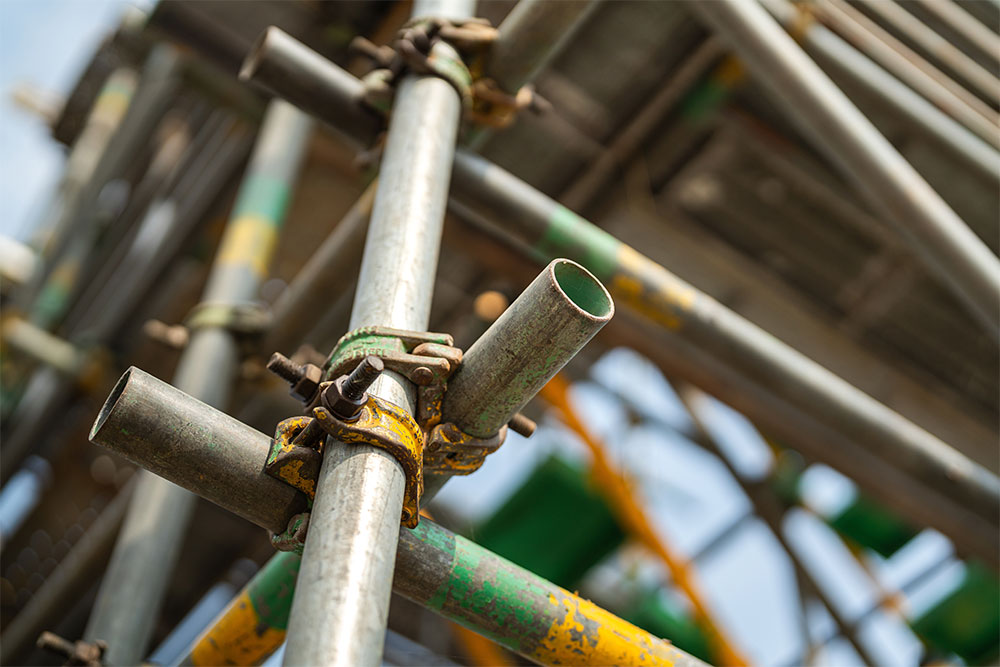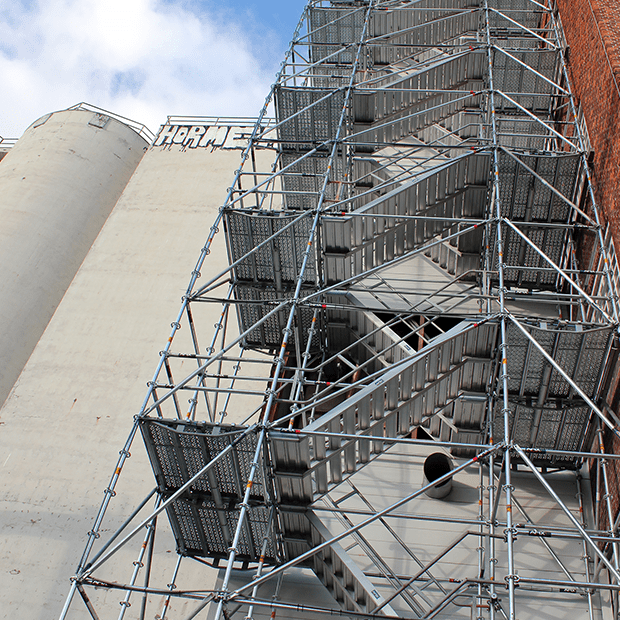Temporary Roof Scaffolding Experts Providing Secure and Reliable Installations
Temporary Roof Scaffolding Experts Providing Secure and Reliable Installations
Blog Article
A Comprehensive Guide to the Vital Functions of Scaffolding in Modern Construction
The landscape of modern-day building and construction increasingly depends on effective scaffolding systems that prioritize safety and security, performance, and innovation. As tasks expand in intricacy, comprehending the crucial features of scaffolding ends up being important for making certain employee safety and security and optimizing project timelines. This guide explores various sorts of scaffolding, highlights essential security functions, and analyzes material advancements that add to efficiency and sustainability. Nonetheless, the implications of these elements extend far past plain building techniques, prompting a more detailed take a look at exactly how they affect total job success and worker well-being.
Sorts Of Scaffolding
Although scaffolding systems can differ commonly in layout and application, they usually fall under a number of unique categories that satisfy various building requirements - Scaffolding. The most typical kinds include sustained scaffolding, suspended scaffolding, and rolling scaffolding
Supported scaffolding is composed of systems supported by a structure of poles, which offer a elevated and stable functioning surface. This kind is generally utilized for tasks that call for significant elevation, such as bricklaying or external paint.
Put on hold scaffolding, alternatively, is used for projects calling for accessibility to high altitudes, such as cleansing or repairing structure facades. This system hangs from a roof or one more structure, permitting employees to reduced or increase the system as needed.
Moving scaffolding features wheels that enable easy mobility throughout a job site. It is specifically useful for tasks that require constant relocation, such as interior operate in large areas.
Each type of scaffolding is designed with certain applications in mind, making certain that construction projects can be accomplished efficiently and properly. Comprehending these groups is important for choosing the appropriate scaffolding system to fulfill both project demands and site problems.
Trick Security Features
Safety is paramount in scaffolding systems, as the potential threats related to functioning at elevations can lead to significant crashes if not effectively handled. Trick safety and security functions are necessary to make certain the health of workers and the stability of the building website.
Most importantly, guardrails are important. These barriers give a physical protect against falls, significantly decreasing the threat of serious injuries. In addition, toe boards are typically used to prevent tools and materials from falling off the scaffold, securing workers below.
Another crucial element is making use of non-slip surface areas on platforms. This function enhances grip, particularly in damaging climate conditions, consequently minimizing the possibility of slides and falls. Accessibility ladders should be safely positioned to promote secure entrance and leave from the scaffold.
Regular inspections and maintenance of scaffolding systems are additionally vital. These inspections make certain that all elements are in excellent problem and working appropriately, addressing any kind of wear or damages promptly.
Finally, proper training for all workers associated with scaffolding operations is vital to guarantee that they understand safety and security methods and can identify potential hazards. Scaffolding. Collectively, these attributes develop a safer working environment and significantly alleviate dangers associated with scaffolding
Product Advancements
Innovations in product scientific research have considerably influenced the scaffolding industry, improving both safety and security and effectiveness in modern-day building. The introduction of high-strength steel and light weight aluminum alloys has actually transformed traditional scaffolding systems. These materials are not only lighter, making them less complicated to set up and move, yet additionally provide premium load-bearing abilities. This leads to scaffolding frameworks that can sustain greater weights while minimizing the threat of collapse.
Additionally, ingenious composite products, such as fiberglass-reinforced plastics, have emerged as practical options. These products are resistant to corrosion and ecological deterioration, thus extending here are the findings the life expectancy of scaffolding systems, specifically in harsh climate condition. Making use of such products adds to reduce maintenance costs and makes sure constant performance gradually.


Design Factors To Consider
Considering the complexities of modern-day building tasks, effective scaffolding layout is critical to ensuring both performance and safety and security. Layout factors to consider should include numerous aspects, including load capacity, elevation, and the specific requirements of the building and construction website. Each task provides special challenges, demanding a flexible method to scaffolding systems that can adjust to differing problems.
Architectural integrity is vital; as a result, engineers should compute the loads that the scaffolding will certainly sustain, including employees, products, and tools. The choice of materials plays a critical function in guaranteeing the scaffolding can withstand these lots while staying sturdy and lightweight. Furthermore, the style has to enable very easy access and egress, promoting the smooth activity of employees and materials.
Safety attributes, such as guardrails and non-slip surfaces, must be included to minimize dangers of mishaps. The design should think about the surrounding setting, consisting of prospective hazards and adjacent frameworks. By resolving these layout factors to consider, construction companies can enhance the efficiency of scaffolding systems and advertise a much safer working environment, eventually adding to the overall success of the project.
Upkeep and Inspections
The performance of scaffolding systems prolongs past initial layout and application; ongoing maintenance and normal inspections are vital to guaranteeing their continued efficiency and safety and security throughout the period of a task. Normal evaluations ought to be conducted by qualified personnel to identify any type of signs of wear, damage, or instability that could jeopardize the integrity of the scaffolding.
Upkeep methods must consist of regular checks of architectural parts, such as fittings, frames, scaffolder assistant and planks, guaranteeing that all aspects remain cost-free and secure from rust or other degeneration. In addition, the functionality of safety and security attributes, such as guardrails and toe boards, need to be evaluated to ensure compliance with safety guidelines.
Paperwork of all evaluations and upkeep tasks is critical for liability and governing compliance. An organized approach to record-keeping not just aids in tracking the problem of the scaffolding however additionally supplies essential proof in the event of a case.
Ultimately, developing a thorough maintenance and evaluation schedule will considerably decrease the threat of accidents and improve scaffold end caps the total safety of the construction site. By focusing on these techniques, construction supervisors can safeguard workers and maintain the job's honesty.

Final Thought
Finally, the essential attributes of scaffolding in modern-day construction include a variety of critical aspects, including varied types, key safety devices, product technologies, and thoughtful style factors to consider. Highlighting security with guardrails and non-slip surface areas, together with improvements in products like high-strength steel, boosts both efficiency and sustainability. Normal upkeep and evaluations are essential for making sure architectural integrity and safety and security on building websites, eventually assisting in effective project execution and advertising the health of employees.
The landscape of modern construction progressively relies on reliable scaffolding systems that focus on advancement, efficiency, and safety and security.Advancements in product scientific research have substantially affected the scaffolding market, boosting both security and performance in contemporary construction. Generally, these material advancements not just enhance the performance and security of scaffolding systems yet additionally line up with the industry's push towards sustainability, as many contemporary products are made to be much more ecologically pleasant.
Taking into consideration the intricacies of contemporary building and construction tasks, reliable scaffolding layout is extremely important to guaranteeing both performance and security.In verdict, the crucial features of scaffolding in modern construction include an array of important elements, including varied types, crucial safety systems, material developments, and thoughtful layout factors to consider.
Report this page